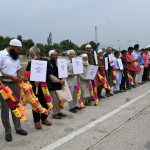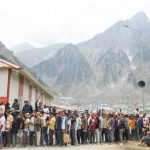Rural areas of Jammu and Kashmir are becoming an important part of growth story scripted by the remarkable initiatives of Lieutenant Governor Administration.
Administration is focusing on meeting the aspirations of rural population, bridging gaps in rural infrastructure and strengthening the co-operative credit systems to transform the rural economy of J&K.
Stress of the Government is on the development of rural economy for unlocking its full potential by filling the gaps vis-à-vis infrastructure, human resources and financing.
The Administration is ensuring that the rural economy actively participates in this growth process and stressed on need for inter-sectoral coordination to improve infrastructure, empowerment of women & employment generation.
The road to Jammu and Kashmir’s prosperity passes through its villages and high priority is accorded to the rural development. Highlighting the role of rural infrastructure, self-employment, and agrarian society, he said policies of present administration is based on pragmatism in order to harness the tremendous potential of villages.
Notably, around 70 per cent of J&K’s population is dependent on agriculture and allied activities. The development in rural areas is not just about self-sufficiency in food production but also about increasing yields and income, making the people more empowered.
Lieutenant Governor, Manoj Sinha has directed the officers to adopt rural development policies which are based on pragmatism and strengthen the planning and implementation at the panchayat level.
“Each and every policy must improve the lives of people living in villages. Today, more than 56,000 self-help groups are acting as facilitators of development. Our aim should be to enhance the capacity and scale of these groups with financial support, market linkage, special knowledge and skills that can be used to change the face of rural J&K,” he said at a meeting.
It is worth to mention that important projects in agriculture, animal sheep husbandry, horticulture, skill development, cooperatives, road, power development, and Jal Shakti sector have been completed last two years. The focus of administration is on strengthening economic relationship between farm and market to benefit the farmers and rural population and making benefits of innovation, technologies available to rural population and agrarian society.
The steps taken by the government will integrate rural areas into modern economic units and increased business opportunities in agro and rural industry can transform the rural economy. Adequate attention is being paid to public-private partnership to increase the income of rural population and both farm and non-farm economy is being incentivised to create well-equipped and self-sufficient villages.
Jammu and Kashmir has embarked on a mission to reach out to unconnected habitations and in three years it has achieved considerable targets and achievements under various schemes, programmes implemented for construction, improvement, upgradation of roads and bridges with special focus on rural areas.
Emphasis is being laid on improving the road network has proven that the government is committed to the welfare of the people and attention is being paid towards providing basic amenities which included developing road infrastructure for the common residents in J&K.
The new roads have brought villages closer to the cities and are helping the farmers to reach the markets in time. Perishable items cultivated by them are selling like hot cakes as these are reaching the customers on time. Farmers are getting a good price for their yield. This factor is encouraging them to focus on increasing their production.
In a first of its kind, the Government of Jammu and Kashmir embarked on an ambitious and extensive programme of reaching out to the people at the grassroots level to create in the rural masses an earnest desire for decent standard of living.
The ‘Back to Village’ programme is aimed to involve the people of J&K and government officials in a joint effort to deliver the mission of equitable development and is aimed at energizing Panchayats and directing development efforts in rural areas through community participation.
As part of this programme, civil servants reached out to each Panchayat, where they stayed for a specific period to interact and obtain feedback from the grassroots so as to tailor government efforts in improving delivery of village-specific services.








